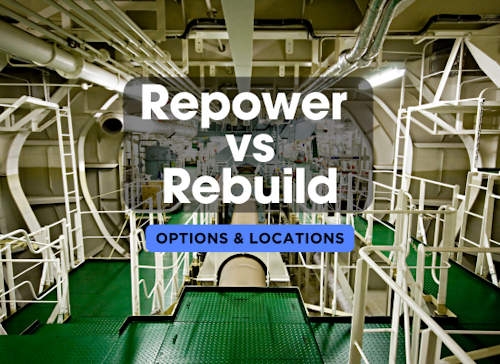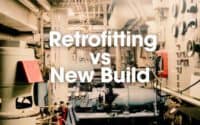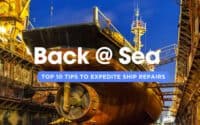Repower or Rebuild? The Best Options and Locations for Major Ship Engine Work

When deciding between rebuilding or repowering a ship's engine, shipowners face a critical choice that can impact operational efficiency, compliance with environmental regulations, and overall costs. Rebuilding an engine involves overhauling existing components to extend its lifespan, often at a lower initial cost, but may not fully address modern fuel efficiency or emission standards. On the other hand, repowering involves replacing the old engine with a new, more advanced model, offering long-term benefits in fuel savings and regulatory compliance but requiring a higher upfront investment. Understanding the advantages and trade-offs of each option is essential for making the best decision for your fleet.
Repowering offers long-term benefits with improved fuel efficiency, compliance with modern regulations, and a new engine lifespan but requires a higher upfront investment and a similar time out of water as rebuilding.
Rebuilding is more cost-effective in the short term, with lower initial costs and the ability to extend the engine's life, but may not provide the same efficiency gains or regulatory compliance as repowering.
Example Cost Breakdown:
MAN B&W 6S50MC Engine on a 1980s Handymax Bulk Carrier
Disclaimer: These figures can vary, wildly.
1. Repowering
Cost Breakdown:
- New Engine Purchase: $2,000,000 - $2,500,000
- Removal of Old Engine: $200,000 - $300,000
- Installation of New Engine: $400,000 - $600,000
- Modifications to Engine Room: $250,000 - $500,000
- New Control Systems: $150,000 - $250,000
- Testing & Commissioning: $100,000 - $200,000
- Spares & Contingencies: $100,000 - $200,000
Total Cost Estimate: $3,200,000 - $4,550,000
Time Out of Water:
- Dry Docking: 2-3 weeks
- Removal of Old Engine: 1-2 weeks
- Installation of New Engine & Modifications: 4-6 weeks
- Testing & Commissioning: 1-2 weeks
Total Time Out of Water: 8-13 weeks
Considerations for Repowering:
- Fuel Efficiency Improvements: Up to 15-20% compared to older engines.
- Compliance with New Emission Standards: Meets IMO Tier II or Tier III regulations.
- Longer Engine Lifespan: A new engine can extend the ship's operational life by another 20-30 years.
- Higher Initial Investment: Significant upfront costs but potential savings in fuel, maintenance, and compliance.
2. Rebuilding
Cost Breakdown:
- Engine Overhaul Parts (Cylinders, Pistons, Bearings): $500,000 - $800,000
- Labor Costs: $200,000 - $300,000
- Machining & Reconditioning of Components: $150,000 - $250,000
- Reassembly & Installation: $100,000 - $200,000
- Testing & Commissioning: $50,000 - $100,000
- Spares & Contingencies: $50,000 - $100,000
Total Cost Estimate: $1,050,000 - $1,750,000
Time Out of Water:
- Dry Docking: 2-3 weeks
- Disassembly of Engine: 1-2 weeks
- Machining & Reconditioning: 3-4 weeks
- Reassembly & Installation: 2-3 weeks
- Testing & Commissioning: 1-2 weeks
Total Time Out of Water: 9-14 weeks
Considerations for Rebuilding:
- Lower Initial Costs: Rebuilding is generally less expensive than repowering.
- Extending Engine Life: A rebuild can extend the engine's life by 5-10 years.
- Fuel Efficiency: May improve slightly, but not as much as with a new engine.
- Compliance Issues: Might still require additional investments to meet current emission standards.
- Risk of Future Breakdowns: Rebuilt engines may not be as reliable as new ones, especially if the engine has already seen significant wear.
| ShipUniverse: Repower vs. Rebuild Pros and Cons | ||
|---|---|---|
| Aspect | Repower | Rebuild |
| Initial Cost |
- **High upfront cost** due to purchasing a new engine and required modifications. - **Investment in the future** with long-term savings on fuel and maintenance. |
- **Lower upfront cost** compared to repowering. - **Cost-effective solution** for extending engine life without significant investment. |
| Fuel Efficiency |
- **Significant improvement** in fuel efficiency with modern engine technology. - **Potential savings** of 15-20% on fuel consumption over older engines. |
- **Minimal improvement** in fuel efficiency, as existing engine design remains. - **Fuel consumption** might improve slightly but not to the level of new engines. |
| Compliance with Emission Standards |
- **Meets latest IMO regulations**, including Tier II or Tier III standards. - **Future-proofing** against stricter environmental regulations. |
- **May not meet current standards** without additional upgrades. - **Risk of non-compliance** with future regulations, leading to potential fines. |
| Downtime / Time Out of Service |
- **Similar downtime** to a rebuild but depends on engine availability. - **Typically 8-13 weeks** depending on the complexity of the installation. |
- **Moderate downtime** with the possibility of a quicker turnaround. - **Typically 9-14 weeks** depending on the extent of the rebuild. |
| Long-term Reliability |
- **Highly reliable** with a brand-new engine, extending operational life by 20-30 years. - **Reduced risk** of unexpected failures and repairs. |
- **Improved reliability** over current engine condition, but not as reliable as a new engine. - **Engine life extended** by 5-10 years, with possible risks of older part failures. |
| Operational Costs |
- **Lower operational costs** over time due to improved fuel efficiency and less frequent maintenance. - **Higher initial investment** is offset by savings in fuel and compliance costs. |
- **Potentially higher operational costs** due to less efficient fuel consumption. - **Maintenance costs** may be lower initially but could increase as the engine ages. |
| Environmental Impact |
- **Lower environmental impact** due to reduced emissions and improved fuel efficiency. - **Aligns with green initiatives** and global efforts to reduce carbon footprint. |
- **Higher environmental impact** with older technology and less efficient combustion. - **Potential need for retrofits** to meet environmental standards, increasing costs. |
| Future Flexibility |
- **Greater flexibility** with a new engine designed to accommodate future technology upgrades. - **Ease of integration** with modern ship systems and digital controls. |
- **Limited flexibility** as the rebuilt engine is based on older technology. - **Challenges in integrating** with newer systems without additional upgrades. |
When it comes to deciding where to repower or rebuild a ship's engine, location plays a crucial role in determining the overall cost, quality of work, and time efficiency. Choosing the right location can lead to significant savings and ensure that the work is done to high standards. Here's a breakdown of recommended regions and countries where you can consider repowering or rebuilding your ship's engine, along with the factors that make these locations attractive.
| ShipUniverse: Where to Repower and Rebuild Ship Engines | ||||
|---|---|---|---|---|
| Location | Recommended Countries | Why Choose This Location? | Cost Efficiency | Example Shipyards |
| Southeast Asia | Singapore, China, Vietnam |
- Lower labor costs compared to Western countries. - High-quality shipyards with state-of-the-art facilities. - Experienced workforce with quick turnaround times. |
High |
- Keppel Shipyard (Singapore) - COSCO Shipping Heavy Industry (China) - Saigon Shipbuilding Industry Corporation (Vietnam) |
| Eastern Europe | Poland, Romania, Turkey |
- Skilled workforce with a long tradition in shipbuilding. - Competitive pricing for labor and materials. - Strong expertise in handling complex engine rebuilds. |
Moderate to High |
- Remontowa Shipyard (Poland) - Daewoo-Mangalia Heavy Industries (Romania) - Sefine Shipyard (Turkey) |
| South Korea | South Korea |
- World-renowned for advanced shipbuilding and repair. - High efficiency and cutting-edge technology. - Excellent quality control and standards. |
Moderate |
- Hyundai Heavy Industries (Ulsan) - Samsung Heavy Industries (Geoje) - Daewoo Shipbuilding & Marine Engineering (Okpo) |
| Middle East | United Arab Emirates, Oman |
- Strategic location for ships operating in Asia and Europe. - State-of-the-art facilities with a focus on large vessels. - Competitive pricing due to economic zones. |
Moderate to High |
- Drydocks World (Dubai, UAE) - Oman Drydock Company (Oman) |
| South America | Brazil, Argentina |
- Emerging market with growing ship repair capabilities. - Potential cost savings with lower labor rates. - Close proximity to major shipping routes in the Atlantic. |
Moderate |
- Estaleiro Atlântico Sul (Brazil) - Tandanor Shipyard (Argentina) |
| Western Europe | Germany, Netherlands |
- High standards of engineering and precision. - Advanced shipyards with a focus on eco-friendly solutions. - Strong reputation for quality and reliability. |
High |
- Blohm+Voss (Germany) - Damen Shipyards Group (Netherlands) |
| South Asia | India, Sri Lanka |
- Low labor costs with growing expertise in ship repair. - Strategic location for Indian Ocean shipping routes. - Government incentives and support for maritime industry. |
High/td> |
- Cochin Shipyard (India) - Colombo Dockyard (Sri Lanka) |

Do you have a Maritime Product or Service that may be of interest to Shipowners? Tell us about it here!
Do you have feedback or insights? Please reach out to editor @ shipuniverse.com



